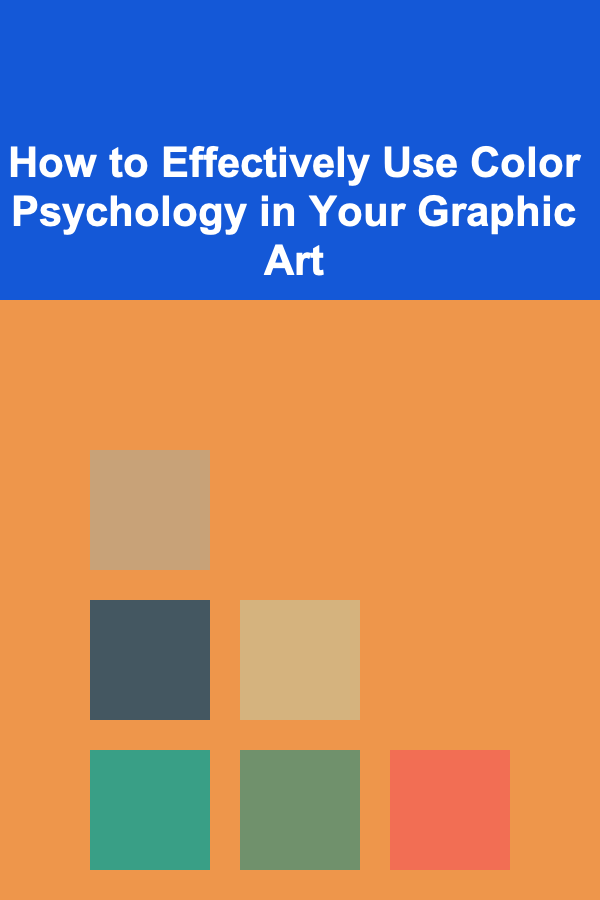
How to Effectively Use Color Psychology in Your Graphic Art
ebook include PDF & Audio bundle (Micro Guide)
$12.99$10.99
Limited Time Offer! Order within the next:

Color psychology plays a crucial role in design, especially in graphic art, where colors are used not just for aesthetic appeal but to convey emotions, influence perception, and even drive action. As humans, we instinctively associate colors with specific emotions or reactions, and understanding these associations can enhance the impact of your graphic artwork. This article explores how to effectively use color psychology in graphic art, offering insights into the meanings behind different colors and how they can be applied to create more compelling, emotionally resonant designs.
Understanding Color Psychology
Color psychology is the study of how colors affect human behavior and emotions. While there are some universal interpretations of color, cultural and individual differences can also influence how a color is perceived. For instance, in Western cultures, white is often associated with purity and innocence, whereas in some Eastern cultures, it can be linked to mourning.
In graphic art, color choices are not just about making something visually appealing; they are about conveying a message and evoking specific emotions in the viewer. As a designer, it's crucial to understand the basic psychological effects of colors and use them strategically to enhance the communication of your artwork.
The Role of Color in Design
Color can affect the mood of a design, define the visual hierarchy, create a sense of unity, and even influence the user's behavior. Whether you're designing a logo, a website, a poster, or social media graphics, every color you choose sends a message to your audience. Let's explore how different colors are generally perceived and how you can apply this knowledge to your graphic art.
Red: Energy, Passion, and Urgency
Red is a powerful color associated with energy, passion, love, and excitement. It can also represent danger or warning, making it a color that demands attention. In graphic art, red can be used to create a sense of urgency, encourage action, or highlight an important element in your design. Red is often used in call-to-action buttons, advertisements, and promotional materials.
However, red can also be overwhelming if overused. It's best used in moderation and combined with other colors to balance its intensity. For instance, pairing red with a neutral color like black or white can tone down its boldness while still maintaining its powerful impact.
When to use red:
- To grab attention or convey urgency (e.g., limited-time offers).
- To evoke strong emotions like passion, love, or excitement.
- In designs that require high energy, such as sports logos or fast food branding.
Blue: Trust, Calm, and Professionalism
Blue is one of the most universally liked colors, and it is often associated with trust, professionalism, and calmness. Many corporate logos and websites use blue to convey reliability and authority. In graphic design, blue is ideal for designs that need to instill a sense of security, stability, and trustworthiness.
Different shades of blue can evoke different feelings:
- Light blue: Calm, peaceful, and serene.
- Dark blue: Professional, trustworthy, and authoritative.
When to use blue:
- For corporate branding and professional websites.
- When designing healthcare, financial, or technology-related art where trust and reliability are essential.
- To evoke a calm, peaceful atmosphere, such as in designs for meditation or wellness brands.
Yellow: Optimism, Happiness, and Attention
Yellow is a bright, cheerful color that represents optimism, happiness, and creativity. It's often used in designs to evoke feelings of joy and positivity. Yellow is also a color that easily grabs attention, making it effective for highlighting key elements in a design or drawing attention to specific actions (e.g., buttons or calls to action).
However, too much yellow can become overwhelming or cause visual fatigue, so it's best used sparingly and in combination with other colors.
When to use yellow:
- For designs that need to convey energy, optimism, and fun (e.g., children's products or entertainment).
- In marketing materials that aim to create a sense of urgency or encourage impulsive actions.
- To draw attention to specific elements in the design, such as icons or call-to-action buttons.
Green: Growth, Balance, and Harmony
Green is associated with nature, growth, health, and harmony. It's often used in designs related to sustainability, environmental issues, and wellness. Green can evoke a sense of tranquility and balance, making it an excellent choice for designs that aim to promote well-being, relaxation, or environmental consciousness.
The color green is also linked to wealth and prosperity, especially darker shades, which is why it is commonly seen in financial and investment-related designs.
When to use green:
- In designs related to health, wellness, and nature.
- To convey a sense of balance, growth, and prosperity.
- In eco-friendly or sustainability-focused branding.
Orange: Creativity, Warmth, and Enthusiasm
Orange is a vibrant and energetic color that combines the warmth of red and the optimism of yellow. It's often associated with creativity, enthusiasm, and adventure. Orange can create a fun, friendly, and approachable vibe, making it ideal for designs targeting younger audiences or for promoting new and innovative products.
However, like red, orange can be overpowering when overused. It's best to use orange to highlight key elements and complement other, more neutral colors.
When to use orange:
- In designs that need to evoke enthusiasm, fun, or creativity.
- For products or services targeting a younger, adventurous audience.
- In promotions or events where energy and excitement are key themes.
Purple: Luxury, Mystery, and Spirituality
Purple is a color often associated with luxury, royalty, and sophistication. It's also linked to mystery, creativity, and spirituality. In graphic art, purple can add a sense of elegance and exclusivity to your designs. It's particularly effective in the beauty, fashion, and high-end product industries.
While purple can create a regal or luxurious feeling, lighter shades like lavender are more calming and can be used in designs that aim to evoke a sense of peace or spirituality.
When to use purple:
- To evoke luxury, creativity, and exclusivity.
- In designs related to beauty, fashion, or high-end products.
- For brands or products in the spiritual, wellness, or holistic industries.
Black: Sophistication, Power, and Mystery
Black is a color often associated with sophistication, power, and elegance. It's a versatile color that can add a sense of authority and formality to designs. Black is often used in high-end fashion, luxury brands, and minimalist designs. It also evokes mystery and can create dramatic contrasts when paired with lighter colors.
While black can symbolize power and elegance, it can also carry negative connotations, such as mourning or death, depending on the context.
When to use black:
- For luxury, high-end, or sophisticated designs.
- In minimalist designs or modern branding.
- To create dramatic contrasts in your design and emphasize other elements.
White: Purity, Simplicity, and Cleanliness
White is often associated with purity, simplicity, and cleanliness. It's a neutral color that provides a sense of calm and openness. In graphic art, white space (or negative space) is a critical design element that allows other colors and elements to stand out. White is also often used in minimalist designs to create an elegant, clean, and modern look.
However, too much white can make a design feel sterile or uninviting, so it's essential to balance it with other colors.
When to use white:
- In minimalist designs that require clarity and simplicity.
- To evoke purity, cleanliness, and a sense of space.
- For designs that need to highlight other colors or elements in a visually clean and modern way.
Brown: Stability, Reliability, and Earthiness
Brown is a warm, earthy color that conveys stability, reliability, and comfort. It's often associated with the natural world, wood, and organic products. In graphic art, brown can add a rustic, grounded feel to designs. It's frequently used in branding for products related to food, coffee, or environmental sustainability.
Brown is less attention-grabbing than other colors, making it ideal for supporting roles in a design, especially when you want to create a natural or organic atmosphere.
When to use brown:
- For designs related to nature, organic products, or sustainability.
- To create a warm, earthy atmosphere in your artwork.
- In branding for food and beverage, particularly for organic or artisanal products.
Conclusion
Understanding color psychology and how colors influence human emotions and behaviors is essential for creating impactful graphic art. By strategically choosing colors, you can enhance the emotional response to your design and ensure it resonates with your intended audience. From the passionate energy of red to the serene calm of blue, every color tells a story, and as a graphic artist, you have the power to harness that story to craft visually compelling, emotionally engaging, and effective designs.
By considering the psychological effects of colors and applying them thoughtfully, you can create designs that not only look beautiful but also communicate the right message to your viewers.
Reading More From Our Other Websites
- [Home Soundproofing 101] How to Soundproof Floors: Effective Methods for a Quieter Home
- [Scrapbooking Tip 101] Best Eco‑Friendly Scrapbooking Materials for Sustainable Memory‑Keeping
- [Organization Tip 101] How to Store Seasonal Pet Supplies Effectively
- [Mindful Eating Tip 101] Mindful Eating and the Gut Microbiome: Emerging Evidence and Future Directions
- [Personal Investment 101] How to Apply Personal Finance Basics to Create Your First Investment Plan
- [Trail Running Tip 101] Nutrition Strategies for Ultra‑Long Trail Marathon Runs
- [Personal Care Tips 101] How to Prevent Teeth Sensitivity After Using Whitening Strips
- [Home Holiday Decoration 101] How to Create an Advent Calendar Decoration in Your Home
- [Home Party Planning 101] How to Secure Your Home for a Party: Home Party Safety Tips You Can't Ignore
- [Personal Investment 101] How to Interpret Economic Indicators for Investors: A Beginner's Guide to Market Forecasting

How to Incorporate Vintage Lighting Fixtures into Your Decor
Read More
How to Make Money Online as an IoT Solutions Architect: 10 Actionable Ideas
Read More
How to Travel as a Couple on a Budget
Read More
How To Offer Elder Care Services
Read More
How to Learn Wakeboarding: Riding the Waves
Read More
How to Understand the Glycemic Index of Foods
Read MoreOther Products

How to Incorporate Vintage Lighting Fixtures into Your Decor
Read More
How to Make Money Online as an IoT Solutions Architect: 10 Actionable Ideas
Read More
How to Travel as a Couple on a Budget
Read More
How To Offer Elder Care Services
Read More
How to Learn Wakeboarding: Riding the Waves
Read More